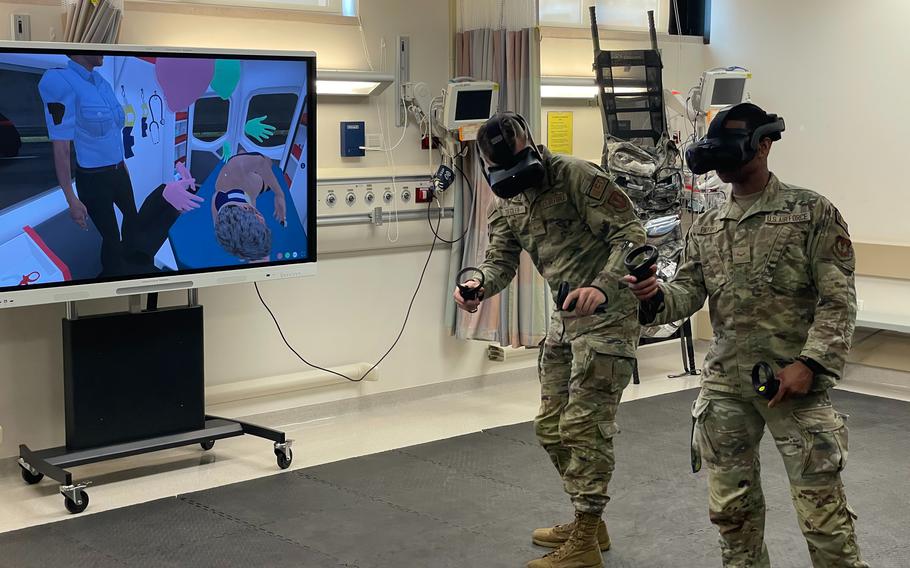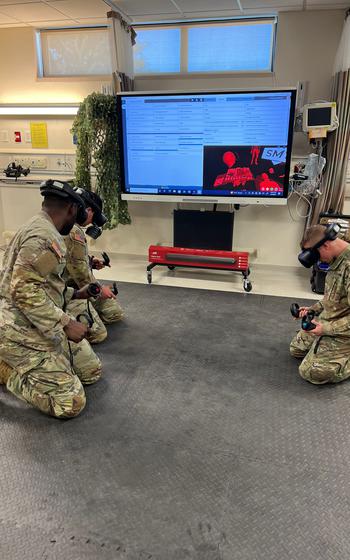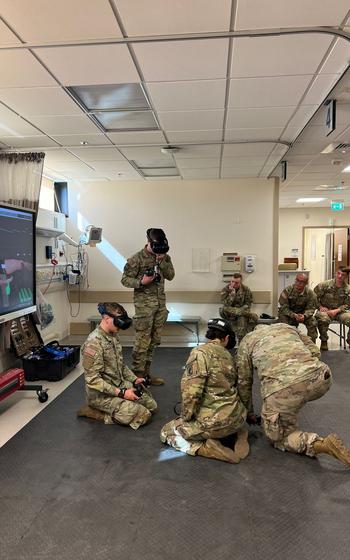
Airmen 1st Class Taylor Ziegler, left, and Tanner Patrick, both aerospace medical technicians with the 31st Medical Group at Aviano Air Base in Italy, simulate caring for a patient in an ambulance using virtual reality headsets on July 11, 2023. (Brian Erickson/Stars and Stripes)
AVIANO AIR BASE, Italy — U.S. military medics at this base in northeastern Italy are jumping from a battlefield to an ambulance to a hospital setting, all at the push of a button and with no travel time required to reach patients.
The virtual reality software used by the 31st Medical Group allows educators to simulate a host of medical scenarios for service members during their annual tactical combat casualty care training.
“With the VR, I can run a situation eight times, and each time I can try to challenge myself with something new,” said Airman 1st Class Taylor Ziegler, an aerospace medical technician. “It (could) be getting patient interaction down or adjusting the algorithm of movements needed to treat the patient in a specific scenario.”
But it’s not just personnel at Aviano who are taking advantage of the software. Soldiers stationed at Caserma Ederle in Vicenza travel two hours for the opportunity to incorporate the technology into their training.

Soldiers from the 173rd Airborne Brigade in Vicenza, Italy, do tactical combat casualty care training on a virtual reality system provided by the 31st Medical Group at Aviano Air Base. (Brian Erickson/Stars and Stripes)
Currently, Aviano is the only Air Force treatment facility in Europe using the virtual reality software to train Defense Department medical personnel.
“This training was acquired for its uniqueness for tactical combat casualty care,” said Maj. Aaron Mangubat, the training flight commander for the unit. “I can take an airman or soldier and instantaneously immerse them in a combat zone to practice casualty care with real-time feedback.”
The system was acquired in December 2022 at a cost of around $100,000, military officials said.
The VR simulations are beneficial regardless of how much experience and medical training the user has, Mangubat added.
The software helps in several ways, including preparing medical workers for professional certifications. It also fosters communication in the intensive care unit or the emergency room, as each department may read patients’ charts somewhat differently.

Members of the Army’s 173rd Airborne Brigade and the Air Force’s 31st Medical Group train with a virtual reality system at Aviano Air Base in Italy. The VR simulations allow service members to switch from a battlefield scene to a hospital emergency room at the touch of a button. (Brian Erickson/Stars and Stripes)
Airman 1st Class Tanner Patrick, an aerospace medical technician who works in ambulance services, said the training has taught him what information the emergency room needs and how to inform them to avoid unnecessary duplication of treatment.
The equipment to run the VR training consists of two laptops, four headsets and a wireless router. An internet connection isn’t required because everything is self-contained in the computer and the router.
The system is easily portable and once more headsets arrive, they’ll likely be moved to more locations.
Master Sgt. Adrian Guillermo Hernandez, the noncommissioned officer in charge of the 31st Medical Group’s ambulance services, noted the integration that the VR simulations are facilitating across the Air Force’s medical fields.
The training is “a stepping stone” to creating an environment in which people in one field work more efficiently with colleagues in others, he said.